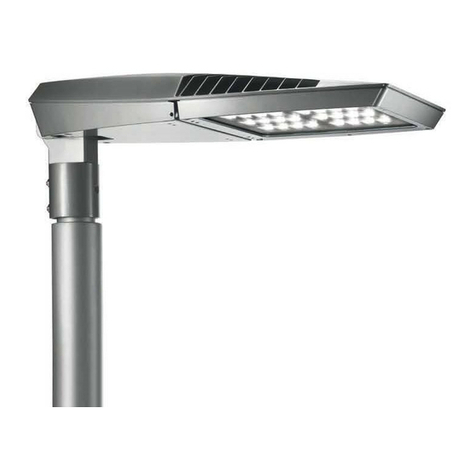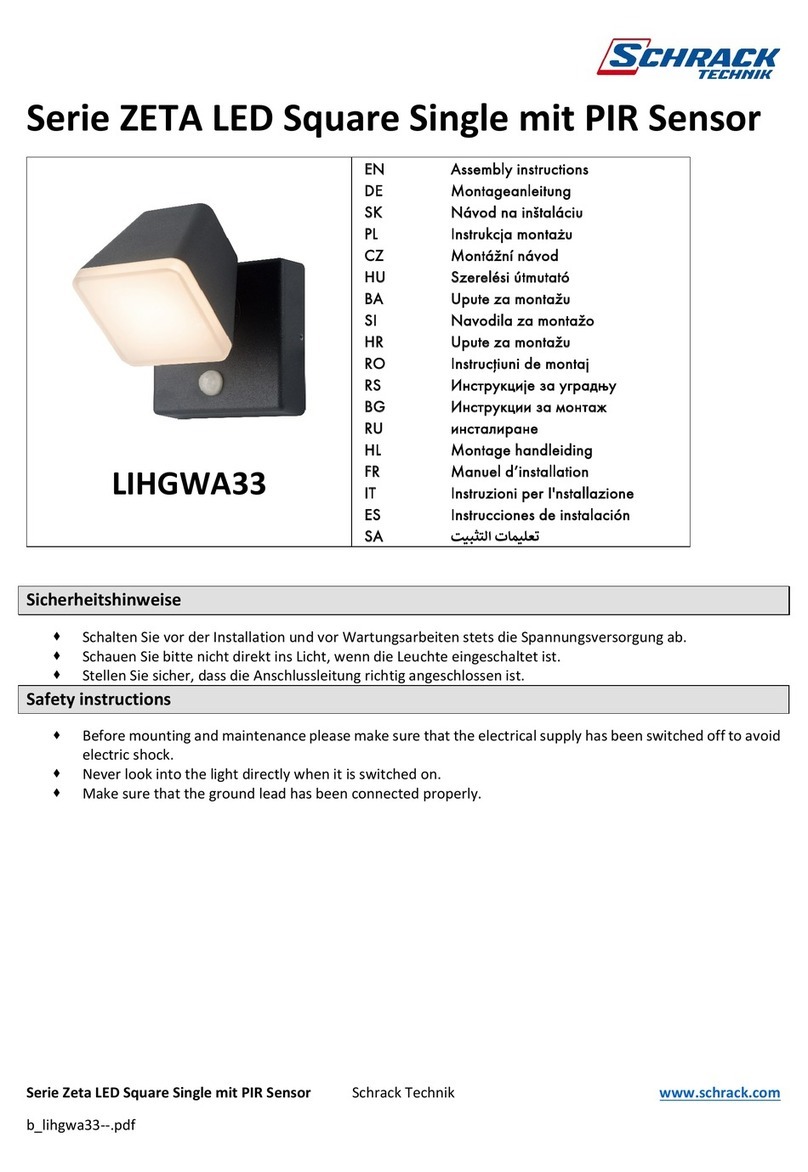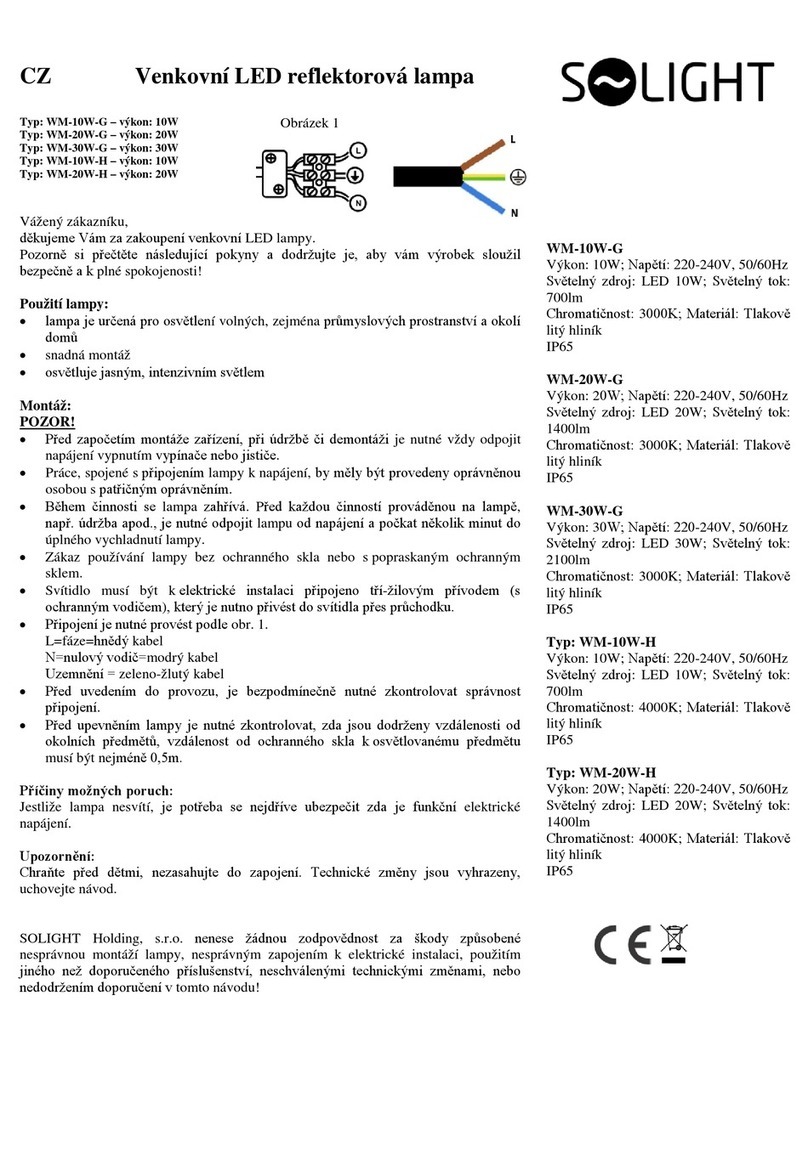Gilras GR-54CCD User manual

USER'S MANUAL

Version:1.0 SLITLAMPUSERMANUAL
2
Thank you for purchasing our slit lamp microscope!The following is the description and
specification of our product.
General description
This user manual elaborates on the relevant technical specification and operation notes of our slit
lamp.
Working principle: A beam of light attached to the slit lamp projects to the patients’ eye, which
forms an optical section of the living tissue of the eye, in this way the doctor can finish the
observation and examination.
Slit Lamp Microscopes are used to observe the disease of the anterior structures and tissue
damage of eyes.
The specification of this slit lamp microscope.
Microscope:
Type: Galilean-Type
Magnification change: Five Position revolving Drum
Eyepieces 12.5X
Angle between eyepieces: 13º
Total magnification Ratio: 6X, 10X, 16X, 25X, 40X
Pupillary adjustment: 52mm~78mm
Diopter adjustment: ±6D
Fieldofview: 40X(∅5.5mm), 25X (∅8.5mm), 16X (∅13.5mm), 10X (∅22mm),
6X (∅34.7mm)
Slit Illumination:
Slit width: Continuously variable from 0 to 14mm (at
14mm,slit becomes a circle )
Slit length: Continuously variable from 1mm to 14mm
Aperture diameters: ∅14mm,∅10mm,∅5mm,∅3mm∅2mm,∅1mm,
∅0.2mm
Slit angle: 0°-180°(Adjustable both vertical and horizontal)
Slit inclination 4 step: 5°, 10°, 15°, 20°
Filters: Heat-absorbing filter,ND filter,Red-free,Cobalt
Blue
Lamp: H: 6V/20W Halogen Lamp
L: 3V3W LED module
Luminance: ≥50klx
Electric-focus digital module specification:
Spec of image sensor: 5,000,000-pixel, 1/2.5-inch high-speed and high-definition
image sensor
Resolution of image: 2592×1936

Version:1.0 SLITLAMPUSERMANUAL
3
Format of image: JPEG
Resolution of video: 1920×1080(Full HD)
Compatible of 1296×960 & 1280×720
Frame rate of video: 25-30fps
Format of video: AVI (MJPEG), MPEG4
Mode of focus: Auto-focus/Focus by moving the roller of the mouse
Mode of exposure: Auto-exposure, auto-gain
Transmission interface: compatible with 100M/1000M Ethernet,
Standard RJ45 interface
Base Longitudinal movement: 90mm
Lateral movement: 100mm
Fine Base movement: 15mm
Vertical movement: 30mm
Chin-Rest
Vertical movement 80mm
Power: Input voltage: 220V/110V~±10%
Input frequency: 50Hz/60Hz
Power Consumption: H: 30VA (max)
L: 20VA (max)
Output voltage: Light: 6V (continuously variable)
Fixation: 3V
Background illumination: 3V
Dimension & Weight:
Dimension 740mm ×450mm x 550mm
Gross weight: 24Kg
Net weight: 20Kg
Working environment
Temperature: +5℃~+40℃
Relative humidity: ≤80%
Air pressure: 800hpa~1060hpa
Storing environment
Temperature: -40℃~+55℃
Relative humidity: ≤93%
Air pressure: 700hpa~1060hpa
Transporting environment
Temperature: -40℃~+55℃
Relative humidity: ≤93%
Air pressure: 700hpa~1060hpa

Version:1.0 SLITLAMPUSERMANUAL
4
General Requirements for Safety
Please read carefully the following precautions to avoid unexpected personal injury as well as
the product being damaged and other possible dangers.
Precautions
1. In case there is any trouble, please first refer to the trouble-shooting guide. If it still
can’t work, please contact the authorized distributor or our Repair Department.
2. Do not use this instrument in the environment prone to fire and blast or where there is
much dust and with high temperature. Use it in room and simultaneously be careful to
keep it clean and dry.
3. Other medical equipment and devices that must be installed in the same place should
follow the same electromagnetic compatibility principle. If the other device cannot
apply to the same principle, please keep a distance of 3 meters at least between the two
devices. And do not share the same power supply cable with the two devices.
4. Check that all the wires are correctly and firmly connected before using. Ensure that
the instrument is well grounded.
5. Please pay attention to all the ratings of the electrical connecting terminal.
6. Turn off the main power first before replacing the main bulb, flash lamp and fuse.
7. When replacing the power cable, please use the power cable in accordance with the
notes in the instruction manual.
8. Don’t touch the surface of the lens and prism with hand or hard objects.
9. To prevent the instrument from falling down to floor, it should be placed on the floor
where the inclination angle is less than 10°
10. Please deal with the waste disposal produced by the machine following relevant laws and
regulations.
11. Read carefully the safety and other signals on this machine in order to use the product
safely.

Version:1.0 SLITLAMPUSERMANUAL
5
THE SAFETY MARKS, PICTURES USED IN THIS INSTRUMENT
No. mark Description
1 TYPE B
2 DATE
3 Class I The slit lamp is type I medical using equipment
4 Type B English form of B type
5
WEEE mark Please deal with the waste disposal
produced by the machine following relevant laws
and regulations.
6 CE marking
7 Part Number
8 Serial Number
9 ON
10 OFF
11 Output At the back of power supply box ,indicate outlet of
the power
12 Input At the back of power supply box ,indicate input of
the power
13 Fuse F1AL250V Rated value and current value
14 Power At the front of power supply box, use with on and
off
15 Voltage selector Change input voltage to adjust the equipment to
work under appropriate voltage
16
The mark of light dimmer.
Icon logo from the narrow to wide, said light source
intensity from weak to strong

Version:1.0 SLITLAMPUSERMANUAL
6
Contents
1NOMENCLATURE .................................................................................................................................................. 7
2ASSEMBLY............................................................................................................................................................. 10
2.1 CHECK LIST....................................................................................................................................................... 10
2.2 ASSEMBLY PROCEDURE ..................................................................................................................................... 11
2.3 CHECKING PROCEDURE AFTER ASSEMBLING ...................................................................................................... 14
3OPERATION PROCEDURES .............................................................................................................................. 15
3.1 DIOPTER COMPENSATION AND PUPIL DISTANCE ADJUSTMENT ........................................................................... 15
3.2 PATIENT POSITION AND USE OF FIXATION TARGET .............................................................................................. 16
3.3 BASE OPERATION ............................................................................................................................................... 16
3.4 OPERATION OF ILLUMINATION UNIT ................................................................................................................... 17
3.5 OPERATION NOTES............................................................................................................................................. 18
4CLEANINGAND DISINFECTION: .................................................................................................................... 19
4.1 CLEANING ......................................................................................................................................................... 19
4.1.1 Cleaning way................................................................................................................................................ 19
4.1.2 Cleaning circle.............................................................................................................................................. 19
5PROTECTINGAND MAINTAINING ................................................................................................................. 19
5.1 PROTECTING...................................................................................................................................................... 19
5.2 MAINTAINING.................................................................................................................................................... 20
5.3 REPLACING THE ILLUMINATION BULB ................................................................................................................ 20
5.4 REPLACING THE FUSE ........................................................................................................................................ 21
5.5 REPLACING THE CHIN-REST PAPER..................................................................................................................... 22
5.6 CONSUMABLES.................................................................................................................................................. 22
5. TROUBLE SHOOTING GUIDE............................................................................................................................... 23
APPENDIX A................................................................................................................................................................... 24
APPENDIX B................................................................................................................................................................... 24

Version:1.0 SLITLAMPUSERMANUAL
7
1Nomenclature

Version:1.0 SLITLAMPUSERMANUAL
8
1. Joystick
Incline joystick to move the instrument slightly on the horizontal surface and rotate it to adjust the
elevation of the microscope.
2. Brightness Control Switch
The brightness can be adjusted continuously. Avoid working continuously at high setting, as the service
life of the bulb will be shortened.
3. Base locking screw
Fasten the screw to lock the base of slit lamp.
4. Microscope Arm Locking Knob
Lock the rotational movement of the microscopes arm.
5. Illumination Arm Locking Knob
Lock the rotational movement of the illumination arm.
6. The indicate of relative angle between the microscope and illumination unit
Mark on the angle mark ring of the illumination arm, which relates to the long mark of the microscope
arm, represent the two arms’ angle when the”0” on the ring relates to the short mark at one side of the
operator the right eyepiece may be blocked, and the side of the patient the left eyepiece.
7. The mark of microscope arm
Together with (6) to indicate the angle between the microscope and illumination unit
8. 12.5X Eyepieces
9. Prism Box
Separate the prism box to adjust the inter papillary distance until it fit for checking
10. Magnification Select Dial
Five different magnifications are provided
11. Slit Height Control Knob
Rotate this knob to adjust the spot and the slit height. Swing the knob horizontally to revolve the slit.
12. Aperture Slit Height and Display Window
It will display the diameter of the slit and the aperture.
13. The Fixation Knob of Lamp Cap
After fixing the knob, the lamp cap will not move.
14. Lamp Cap
With the function of protecting and insulating, its normal working temperature is around 51℃.
15. The plug of Lamp cap
It is connected with the power of the light unit.
16. Filter Selection Lever and display mark
The lever can choose different filters.
17. Tube for connecting the fixation target
This tube is used to connect the fixation target and background illumination module.
18. Forehead Belt

Version:1.0 SLITLAMPUSERMANUAL
9
To fix the patient’s head on an appropriate position
19. The Fixation Knob of Chin-rest Paper
It is used to fix the chin-rest paper.
20. Background illumination module
Provide auxiliary illumination when taking images.
21. Fixation target
Make the patient stare at it, it is convenient for checking
22. Chin-rest
23. Electric-focus digital module
Capture images and connect this module to PC to help the doctor to make diagnosis.
24. Chin-rest Elevation Adjustment Knob
Rotate the knob to adjust the elevation of the chin-rest
25. Slit Width Control Knob
The slit width is continuously adjustable within the range from 0 to 14mm.The marks on the left knob
stands for the approximant value of the width.
26. Access line and plug of the brightness control
27. Rail Cover
Protect the rail surface
28. Work Table

Version:1.0 SLITLAMPUSERMANUAL
10
2Assembly
This section of the manual describes how to assemble the slit lamp. All parts should be taken
out with great care from the packing case before assembling.
2.1 Check List
NO. MARK NAME QUANTITY NOTE
1 A Head-rest part 1 Fig.2.1.1
2 B Microscope part 1 Fig.2.1.2
3 C Illumination part 1 Fig.2.1.3
4 D Electric digital module 1 Fig.2.1.3
5 E Work table part 1 Fig.2.1.4
6 F Rail cover 1 Fig.2.1.5
7 G Power cable 2
8 H Focusing test rod 1 Fig.2.1.6
9 I Protecting cap 1
10 J Chin-rest paper 1
11 K Screw driver 1
12 L Spare bulb (H)1
Fig.2.1.7
13 M User manual 1
14 N Packing list 1
15 O Power adapter 1
16 P Network cable (Rj45) 2
17 Q Mediview image process software
disc 1
Fig.2.1.2
Fig.2.1.1

Version:1.0 SLITLAMPUSERMANUAL
11
2.2 Assembly procedure
1.Open the carton,take out the tools like
screw driver and spanner.
2.Check the setting on the voltage selector
located on the bottom of the power box. If
it doesn’t match with the input voltage,
slide it to the proper position with watch
screw driver. Take out the table unit check
whether the power switch is in the proper
position, if not use the screw driver to
correct it.(caution)
Open the fuse holder with screw driver
and take out the fuse. It has been set to
220V, 1A before leaving factory.
Attention: Set the input voltage and
frequency of the instrument according to
that of the mains.
3.Before attaching the worktable
(Fig.2.1.4)on to the power table, please
screw off four M6x20mm bolts with the
spanner .(Fig.2.2.1 ATeam).
4.Lift the worktable to aim its screw hole at
the assembly hole of the instrument table.
(Fig.2.2.2)
5.Put down the worktable, with the power
panel facing the operator, refasten the bolt
securely with the spanner (Fig.2.2.2).
Fig. 2.1.4
Fig. 2.1.5
Fig. 2.1.6
A Team
B Team
Fig.2.2.1
Fig 2.2.1
Fig.2.1.7
Fig.2.1.3

Version:1.0 SLITLAMPUSERMANUAL
12
The screw to
connect with the
electrical table
6.Connect two white adapters under table
board,Turn on and press Up & Down
switch to check whether the power table
is normal.(Fig.2.2.3).
7.Remove the four screws of B Team with
the screw drive (Fig.2.1.4), take out the
head-rest from carton(Fig.2.1.1),ensure
the four hole on head rest aim the screw
hole of B team(Fig.2.2.1 B team),
retighten the previously removed screw
make head-rest connect with work
table .(Fig. 2.2.4)
8.Take out the slit lamp part (Fig.2.1.3),put
it on the rails of the table board, check
whether the wheels can be rolled steadily
on the rails. (Fig.2.2.5),place the rail
cover to the rail, remove four screws
attached to the rail with the screw drive,
retighten the previously removed screws.
(Fig.2.2.5 and 2.2.6).
9. Take out the binocular tubes of
microscope part (Fig.2.1.2),match the
groove on the binocular tubes with the
pin on the microscope body. Fasten the
fixing screw on the body to the
microscope. ATTENATION :
Don’t touch the objective and eyepiece
when assembling.
Limit pin
Screw
Bayonet
Locking
Screw
on Bas
e
Fig.2.2.5
Rails
Fig.2.2.2
Up & Down
switch
White
Adapters
Fig.2.2.3
Rail
Cover
Fig.2.2.6
Fig.2.2.4
Four
screws
The binocular
tubes
Limit groove
Fig.2.1.2
Fig.2.2.7

Version:1.0 SLITLAMPUSERMANUAL
13
10. Please make sure the power cord of slit lamp is not connected with main power. Connect the
link wire of brightness control knob on the base to the corresponding socket on the power box
(Fig.2.2.9). And then insert the plug of chin-rest bracket in the correct socket, and fasten it
12. Check the voltage selector, this power box support working under the voltage of 110V and
220V. Please select the right voltage according to the voltage in your country.
Caution: Wrong power selection may lead to damage of the instruments.
13. Please connect the digital module to the power adaptor (interface: “To Network Jack”) with one
of the RJ45 network cable. And use the other one to link the power adaptor (interface: “To
Hub/Switch”) to PC.
14. Connect the adapter to main power supply and press down the pole on the digital module. As
the installation of mediview software please refer to the other manual attached.
15. Open the fuse box and make sure there is a fuse assembled
Specification of the fuse is 1A/250V
Fasten
the
locking
screw
Fig.2.2.8
Fig.2.2.9
1. Fuse box
2. Power socket
3. 110V/220V voltage selector
4. Fixation lamp socket
5. Illumination lamp socket
6. Brightness control knob socket Power box socket
There is a limit groove on
the socket. Please align
the plug with the groove.

Version:1.0 SLITLAMPUSERMANUAL
14
16. Clear up all the tools and accessories and then put them into the draw under table top.
2.3 Checking procedure after
assembling
17. This instrument supplies a 3-wire cable.
Please select a proper power socket as
matched. Ensure that the instrument is
grounded well.
18. When the main power switch of the power
box is placed at ‘I’, it turns on, and ‘O’ for
turn off. The main power switch should be
set at the ‘O’ position before connecting the
input cable with the power socket.
19. Turn on the main power switch, and the
pilot lamp will be lighted. Open the light
control knob to examine the brightness. The
power supply signal will turn bright when
power is connected(Fig.3.1.3).
20. Put on focus test rod (Fig.2.1.7),
21. Adjust the slit width control knob and
there should be facula on the black flat
surface of focus test rod, and the brightness
should change.
22. Check the fixation target device to
confirm it is lighted. Ensure it can be
normally lighted (Fig.3.2.1)
23. Check whether all the moveable parts
such as aperture and slit height control knob
(Fig.2.3.2) filter selection lever, joy stick
(Fig.2.3.4) and magnification changer lever
(Fig.2.3.3) etc. could be operated freely.
光阑读数窗
Fi
g
.2.3.2
滤片选择杆
光阑调节钮
裂隙宽度旋
Slit width
control
knob
Fig.2.3.1
Display window
Filter handle
Aperture knob
Fig.2.2.10

Version:1.0 SLITLAMPUSERMANUAL
15
Dark Bright
24. Rotate the brightness control switch
(Fig.3.1.2),the light should be from dark
to bright.
25. As the operation guide for digital module
and the software please refer to the other
user manual attached.
26. After examination, turn off the main
power and cover the instrument with the
dust-proof cover.
3Operation procedures
3.1 Diopter compensation and
Pupil Distance adjustment
①Use of the focusing test rod
The rod is supplied as one of standard
accessories for confirming the
microscope’s accurate adjustment. Insert
it into the main shaft hole with the black
flat surface facing the objective lens i.e.
the direction of the operator (Fig.3.1.1).
ATTENTION:The picture of the
test rod is for reference only; please see the
object as standard. Take out the rod after
the adjustment.
②Brightness adjustment
Switch on the main power switch and set
the brightness control switch (Fig.3.1.3) at
central part. Turn the slit width control
knob (Fig.2.3.1) to make the slit width to
be 2~3mm.
③Adjustment of Diopter compensation
The focus of the microscope is
calibrated according to the emmetropia.
If the operator is an ametropia, he
should adjust the eyepiece diopter.
(Fig.3.1.3).
Suggest adjusting the diopter as following
procedures:
First, rotate the diopter adjustment ring
counter clockwise until the end.(Fig.3.1.3)
Second, rotate the ring clockwise until a
fine slit image appears on the focusing text
rod. At this time, it is also the clearest
observation of the reticule in the eyepiece
Adjust another eyepiece in the same way.
Joystick
Brightness control switch
Fig.3.1.2
Fig.2.3.4
Magnification dial
Fig.2.3.3
Insert the
test rod into
the hole
Fig.3.1.1

Version:1.0 SLITLAMPUSERMANUAL
16
Record the diopter value on each
eyepiece for future reference.
④Interpupillary distance adjustment
Separate the prism box of the
microscope with both hands to adjust
the P.D. until both eyes could see the
same image on the focusing test rod
through the eyepieces, and at the same
time a stereo vision will be obtained.
When adjusting, be sure that the
eyepieces are at the same level
(Fig.3.1.4).
3.2 Patient position and use of
fixation target
1) Position of the patient’s head
Place the patient’s chin on the chin-rest
with the forehead against the forehead-rest
belt. Adjust the chin-rest elevation
adjustment knob below the chin-rest
until the patient’s can thus align with the
horizontal mark (Fig.3.2.1).
2) Use of the fixation target
For fixing the patient’s sight, just make
him look at the fixation target with the eye
not to be examined. Move the lamp bar to
change fixing position, so as to achieve the
correct lamp position
3) Background illumination module
This is used to provide supplementary
illumination. Press the red button to turn
on the module. And the module can be
rotated to the comfortable angle the user
need. Please turn of the module when no
in use.
3.3 Base operation
1) Horizontal rough adjustment
Keep the joystick erect and move the base
to make the microscope move on the
horizontal surface to aim at the object
appropriately (Fig.3.3.1)
2) Vertical adjustment
Rotate the joystick to adjust the
microscope’s height until it aligns with the
target. Turn the joystick clockwise to raise
the microscope and counter clockwise to
lower it. (Fig.3.3.1).
3) Horizontal Fine adjustment
Tilt the joystick to make the microscope
move slightly on the horizontal surface.
Diopter
adjustment ring
Fig.3.1.3
the prism
box
Fig.3.1.4
Fig.3.2.1
Chin-res
t
Chin-rest
elevation
adjustment
handle
Belt
Background
illumination
Fixation

Version:1.0 SLITLAMPUSERMANUAL
17
While watching though the eyepieces, tilt
the joystick to aim accurately at the object
for a fine image. (Fig.3.3.1)
4) Locking the base
When finishing the adjustment, fasten the
base locking screw to lock the base to
prevent it from sliding. (Fig.3.3.2)
3.4 Operation of illumination
unit
1) Changing the slit width
Turn the slit width control knob (Fig.2.3.1)
and the slit width will be changed from
0mm to 14mm. The slit becomes a circle
at the 14mm size. The width value is
indicated approximately by the scale on
the knob. (Fig.3.4.1)
2) Changing the aperture and slit height
Turn the aperture and slit height control
knob and 7 different circular beams of
light are available at full aperture:
14,10,5,32,,1,0.2 Dia. Respectively and
one continuously changing aperture With a
slit image, the slit height can be changed
continuously from 1 to 14mm, which is
indicated though the display window
(Fig.3.4.2).
3) Rotating the slit image
Swing the aperture and slit height control;
knob horizontally to revolve the slit image
at any angle in the vertical or horizontal
direction. The angle of image rotation is
indicated by the rotation angle scale with
small division for 5° and big division for
10°(Fig.3.4.3).
4) Decentering the illumination light
Loosen the centering knob and swing the
slit width control knob back and forth so
the light spot moves away from the center
of the microscope vision field. It is mainly
used to examine the eyes by indirect
retro-illumination. Fasten the centering
knob and the slit light will return to the
center of the microscope vision field
(Fig.3.4.3).
Joystick
Fig.3.3.1
Up & Down
Locking
screw
Fig.3.3.2
Slit width
control
knob
Fig.3.4.1
Diaphragm
window
Fig.3.4.2
Filter selection
rod
Aperture
adjustment knob

Version:1.0 SLITLAMPUSERMANUAL
18
5) Oblique illumination
Oblique illumination is used for sectional
or fundus examination by use of a contact
lens. Press down the inclination lever so
that the illumination part may incline to
20°, (5° of each division). Since the
illumination part may touch the
patient’s head, operate carefully
(Fig.3.4.3)
6) Filter selection
By shifting the selection lever four
different filters can be inserted into the
illumination pathway. Usually the thermal
safety filter can make the patients feel
comfortable. After using the other filters,
we should turn back to the thermal safety.
(Fig.3.4.3).
From left to right: No Filter, Heat-absorbing
filter,ND filter,Red-free,Cobalt Blue.
Caution: The no filter is used for
proofreading by the manufacturer.
3.5 Operation notes
1) In the course of the operation the operator
should learn more about the contents of the
user menu, to master the structure and
function of slit lamp microscope so as to
carry out the right operation and diagnosis.
2) In order to prevent unnecessary
observations arising from the misuse of the
judge, operators should observe clearly the
different locations in the knob corresponding
to a different scale and different directional
marks in the process of using the SLM.
3) Operator should adjust the interpupillary
distance and diopter correctly in the
operating or which may lead a feeling of
dizziness
4) Operator may have a feeling of dizziness
in long time observing, so please adjust
observing time according to personal habit.
5) There will be a branch of crack-ray
irradiation in patients’ eyes, when they
receiving SLM diagnosis. So if the light is
too dark, it will affect the observing effect.
Conversely, if the light is too bright, in a long
time exposure patients’ vision might be
affected. If patients feel uncomfortable,
please tell the operator or take medical
treatment. Therefore, please try to avoid
prolonged exposure of patients’ eyes in the
bright light.
Please make sure the pole of the beam splitter
(combined inside the digital module) be
pressed down. Only in this condition, the
digital module can capture images, however,
the light through the eyepieces will be
lessened. So it’s normal that the brightness of
viewing field declines. (fig.3.5.1)
Inclination
lever
Fig.3.4.3
Center knob
Press down the pole

Version:1.0 SLITLAMPUSERMANUAL
19
Fig.4.1.2
4Cleaning and disinfection:
Attention: The replaced waste
materials should be treated as industrial
rubbish.
4.1 Cleaning
4.1.1 Cleaning way
① Cleaning the lens and reflecting
mirror:If any dust stick on the lenses or
reflecting mirror, wipe it off with soft
cotton dipped with absolute alcohol.
(Fig.4.1.1).
Attention: Don’t wipe with hands
or hard project or any corrosive detergent
lest that the surface should be damaged.
② Cleaning the tie plate, rails and shaft:If
the slide plate, rails and shaft are dirty, the
vertical and horizontal movement will be
unsteady. Wipe them with clean soft cloth.
(Fig.4.1.2).
③ Cleaning and sterilizing the plastic parts:
Clean the plastic parts such as chin-rest
bracket, forehead-rest belt with soft cloth
dipped with soluble detergent or water,
then sterilize with medicinal alcohol.
Attention: Don’t wipe with any
corrosive detergent lest that the surface
should be damaged. (Fig.3.2.1).
4.1.2 Cleaning circle
a) Clean the eyepieces, objective lens
and refractor:
Cycle: suggested once every two months.
The lenses are plated with a reflection
reducing coating and reflective coating
on its surface. Although the coating is
hard enough, too frequent wiping will
weaken it, which leads to a bad
observing optical effect. Two month is a
recommendation; if there is lots of dust
on the lens, please wipe it immediately.
b) Cleaning the slide plate, rails and
shaft:
Cycle: suggested once a month
These parts won’t get dirty in a clean
environment such as hospital in one year.
However, we suggest you clean them
once every 6 months so that you can get
a much better movement effect.
c) Cleaning the plastic parts:
Cycle: suggested once a day
These two parts contact with the patients
directly, so please clean them timely.
Please replace a new and clean chin-rest
paper for each patient.
d) Cleaning the whole machine:
Cycle: suggested once every two months.
5Protecting and maintaining
Correct and periodical protecting and maintaining
can prolong the service life of the slit lamp. The
suggested maintaining circle is two months.
5.1 Protecting
There are always dusts and physiological salt
solution dropping into the main shaft hole of
the illumination ram during the operation.
Please cover the main shaft hole with the
protection cap lest the instrument would be
damaged. Take off the cap when the focus test
rod needs to be assembled (Fig.5.1.1).
Reflecting
Mirror
Objective
Fig 4.1.1
shaft
Slide plate
Rail

Version:1.0 SLITLAMPUSERMANUAL
20
5.2 Maintaining
5.2.1. Adjust the slit width control knob
PART ONE:
If the slit width control knob is too loose, the
slit width may be out of control. Loosen the
screw on the right knob with the screw drive ,
then hold the left knob firmly with one hand,
while the other hand rotate the right knob
clock-wise to adjust its tightness. When it is
appropriate, fasten the screw of the right knob
firmly again (Fig.5.2.1.1).
PART TWO:
1. If the slit width control knob is too loose,
the slit width may be out of control. Fasten
the locking screw on right side clockwise
with a hexagon type screw driver.
2. Follow the steps listed below to do the
adjustment.
a) Rotate the locking screw with a hexagon
type screw driver.
b) If the knob is too loose, adjust the screw
clockwise (as fig. 5.2.1.8 shows). If the knob is too
tight, rotate the screw anticlockwise till the knob is
comfortable to use.
5.2.2 Adjusting the inclination of the
illumination part
If the inclination mechanism of the
illumination part is too loose, fasten the screw
on both sides of the pivot point with the screw
driver. (Fig.5.2.2.1)
5.3 Replacing the illumination
bulb
L slit lamp adopts the 3V3W Led module. The life
span of the module is more than 20000 hours. So
it’s no use to replace the module.
H slit lamp adopts 6V20W Halogen bulb. The life
span of the bulb is 480 hours. Please replace the
bulb according to the following steps when the
luminance declines,
1. Turn the main power switch off.
(Fig.3.1.3);
2. Pull out the plug attached to the lamp
house,remove out the fixation knob. Pull up
Protection
ca
p
Fig.4.2.1
Screw
Fig.5.2.2.1
Fi
g
.5.2.1.1
Right
knob
Left
knob
图5.2.1.6
Locking screw
on the right
knob
Fig.5.2.1
Left knob
Right
knob
Fig.5.2.1.8
Table of contents
Popular Outdoor Light manuals by other brands
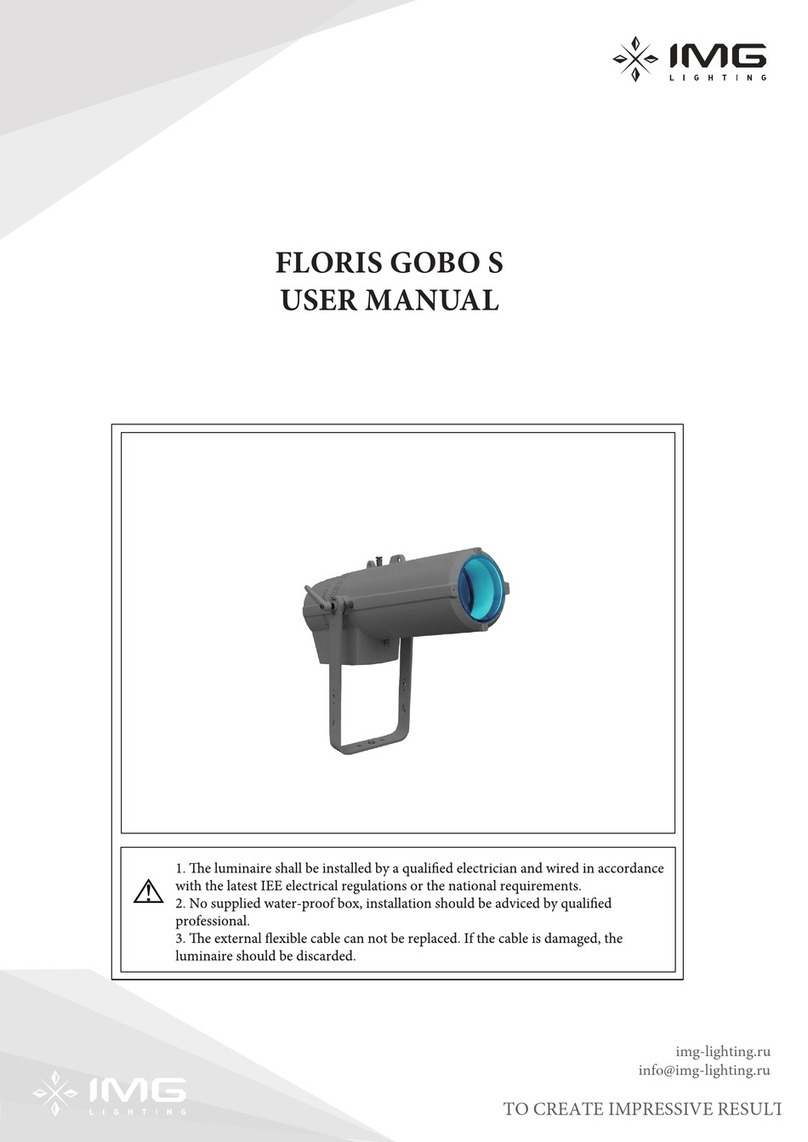
IMG LIGHTING
IMG LIGHTING FLORIS GOBO S user manual
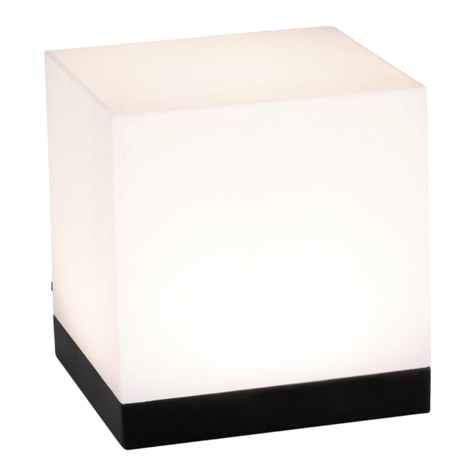
Inspire
Inspire Mood PL-0212-BK instruction manual

Commercial Electric
Commercial Electric S10WPK/850/DD/BZ/HD Use and care guide
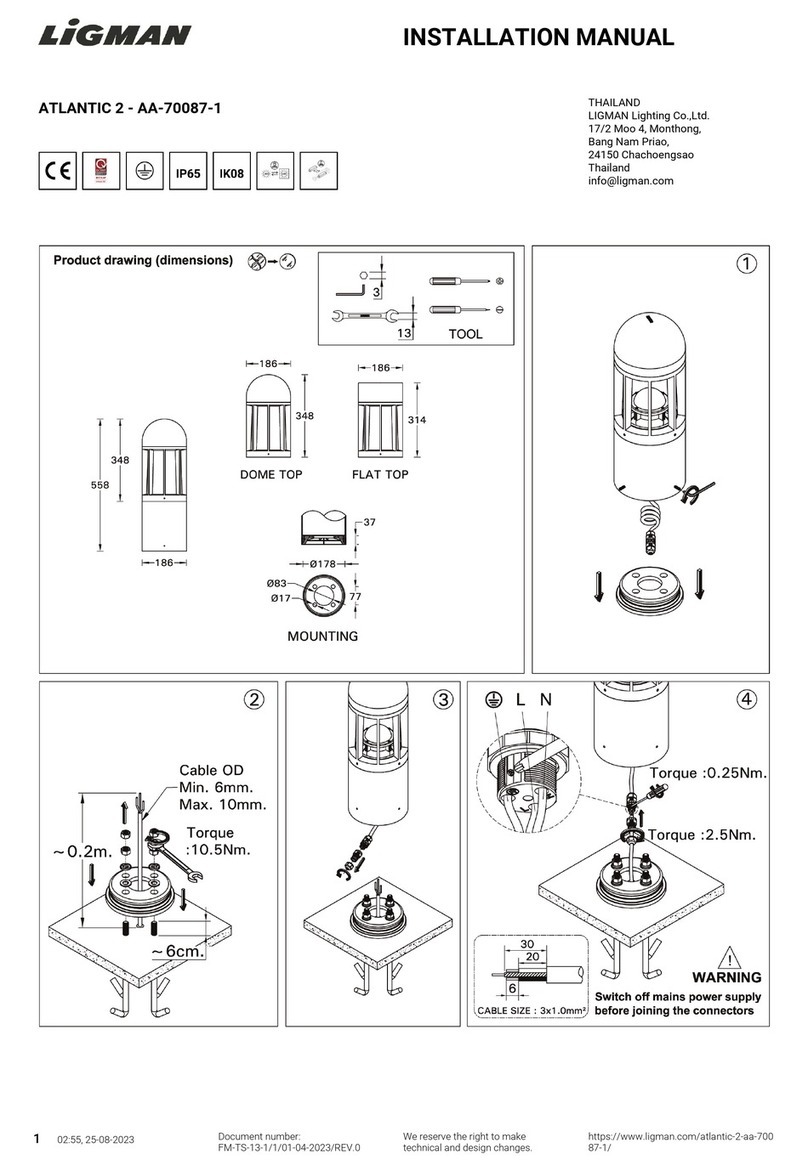
LIGMAN
LIGMAN AA-70087-1 installation manual
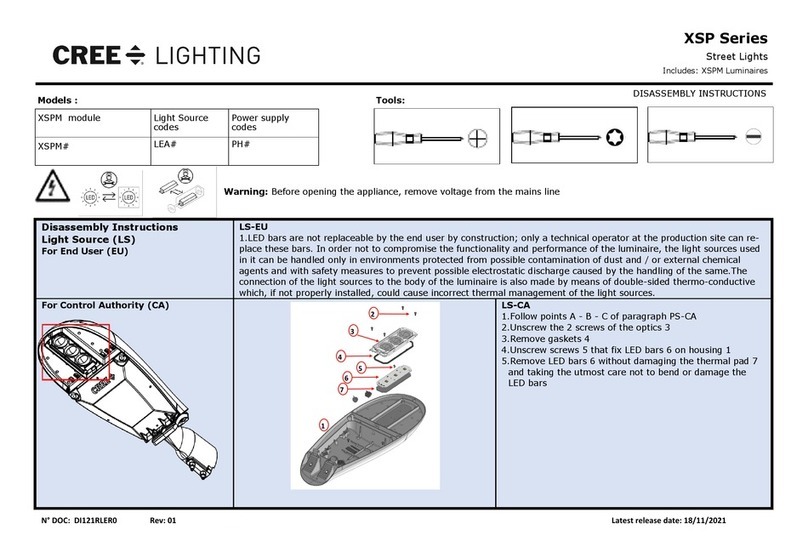
CREE LIGHTING
CREE LIGHTING XSP Series Disassembly instructions
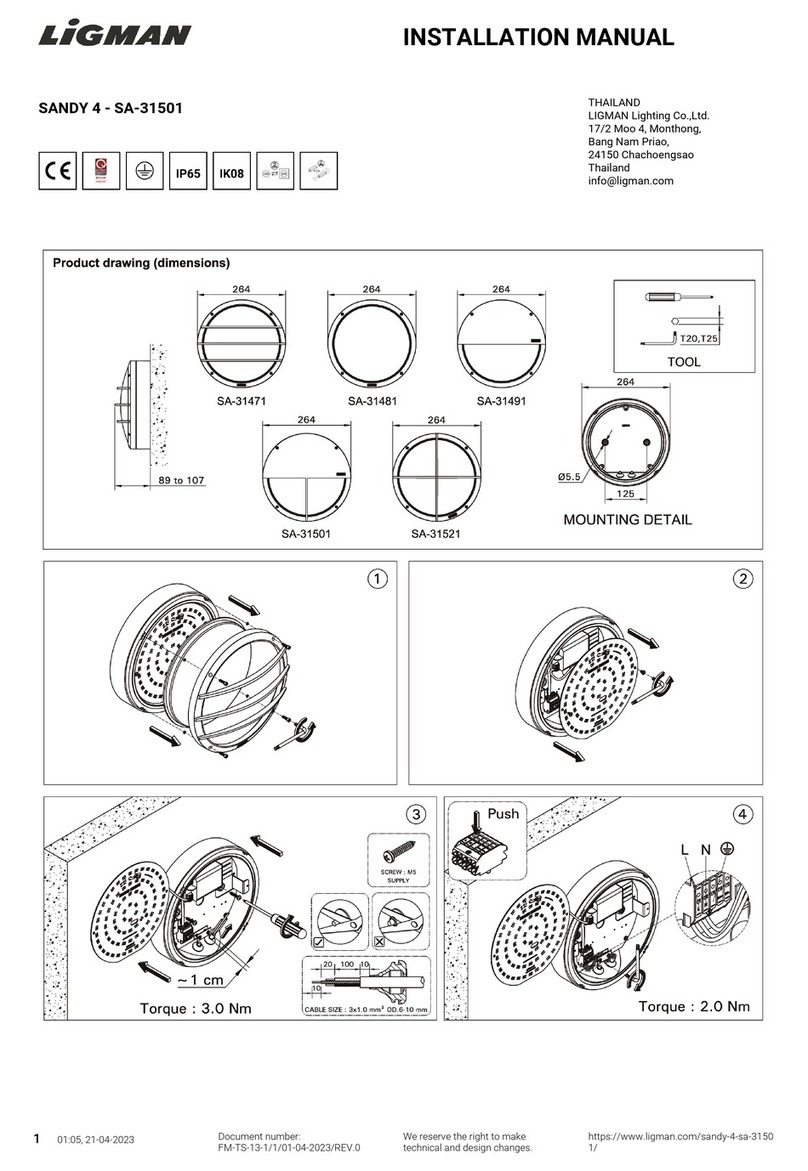
LIGMAN
LIGMAN SA-31501 installation manual

BEL LIGHTING
BEL LIGHTING Atlantic G manual

urban ambiance
urban ambiance UQL1273 installation instructions

BEGA
BEGA 84 423 Instructions for use

WAC Lighting
WAC Lighting Modern Forms FL-1850 Installation instruction
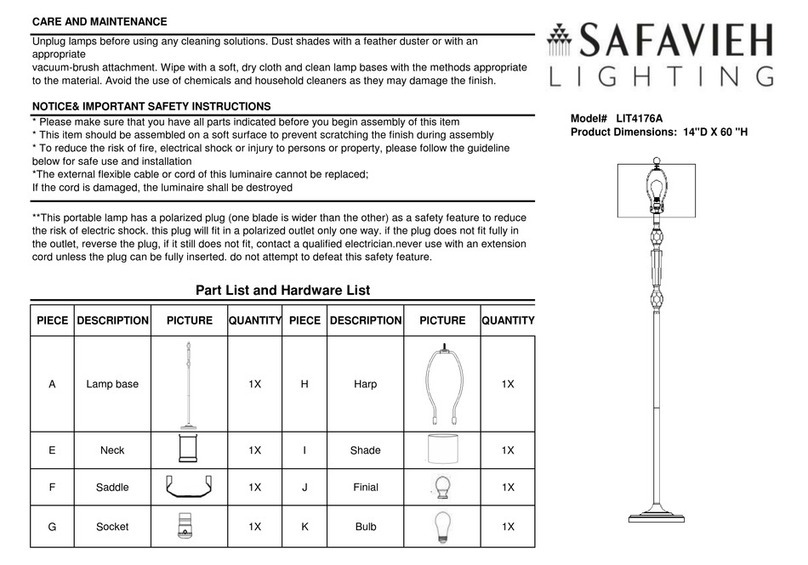
Safavieh
Safavieh LIT4176A quick start guide
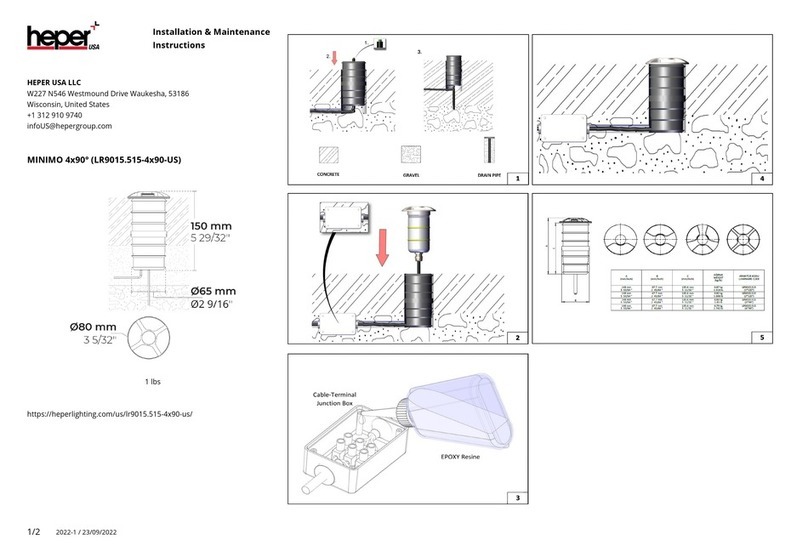
HEPER
HEPER MINIMO 4x90 Installation & maintenance instructions



